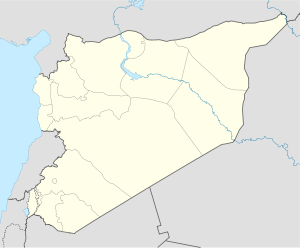- Chagar Bazar
-
Chagar Bazar
تل شاغربازارLocation Al-Hasakah Governorate, Syria Coordinates 36°31′23″N 40°32′06″E / 36.523°N 40.535°E Type settlement History Founded ca. 6,000 BC Abandoned ca. 2,000 BC Periods Neolithic Cultures chagar culture Site notes Excavation dates 1935—1937
1999—2002Archaeologists Max Mallowan
University of Liège
Syrian Directorate-General of Antiquities and MuseumsOwnership Public Public access Yes Chagar Bazar (Arabic: تل شاغربازار) is an ancient site in northern Syria, about 35 kilometers north of Al-Hasakah, occupied from the sixth to the second millennium BC. It is situated by the small river Dara, a tributary to the Khabur River. Alternative spellings are Tell Chagar Bazar, or Šagir Bazar.
Contents
History
Chagar Bazar was already settled in the Neolithic. Excavations revealed pottery belonging to the Halaf and Ubaid cultures. [1] By the Early Bronze Age, in the third millennium BC, Chagar Bazar had turned into a small town with the size of 12 hectares / 30 acres. The site appears to have been abandoned by the end of the third millennium BC. It was resettled by Hurrians in the Middle Bronze Age. Fine examples of the Khabur ware pottery dating to this period have been discovered by the excavators.
Archaeology
The ancient site, about 12 hectares in size, was excavated by the British archaeologist Max Mallowan, with his wife Agatha Christie, from 1935 to 1937. [2] [3] [4] Many of the artefacts discovered were brought to the British Museum. Besides pottery, a large number of clay tablets written in cuneiform script were discovered. Work was resumed at the site in 1999 by an expedition from the British School of Archaeology in Iraq in cooperation with University of Liège archaeologists and the Syrian Directorate-General of Antiquities and Museums. [5] [6] During these excavations, which ended in 2002, 214 cuneiform tablets were recovered.
Notes
- ^ W. Cruells and OP Nieuwenhuyse, The Proto-Halaf period in Syria. New sites New data., Paléorient, vol. 30, no. 1, p. 47-68, 2004
- ^ M.E.L. Mallowan, Excavations at Chagar Bazar and an Archaeological Survey of the Habur Region of North Syria 1934-5, Iraq, vol. 3, no. 1, pp. 1-85, 1936
- ^ M.E.L. Mallowan, Excavations at Tall Chagar Bazar and an Archaeological Survey of the Habur Region, Second Campaign 1936, Iraq, vol. 4, no. 2, pp. 91-177, 1937
- ^ M.E.L. Mallowan, Excavations at Brak and Chagar Bazar, Iraq, no. 9, pp. 1-259, 1947
- ^ Augusta McMahon, Onhan Tunca, and Abdul-Massih Bagdo, New Excavations at Chagar Bazar 1999-2000, Iraq, vol. 63, pp. 201-222, 2001
- ^ A.M. McMahon, C. Colantoni and M.J. Semple, British excavations at Chagar Bazar, 2001-2002, Iraq, vol. 67, no. 2, pp. 1-16, 2003
See also
References
- C. J. Gadd, "Tablets from Chagar Bazar 1936", Iraq, vol. 4, no. 2, pp. 178–185, 1937
- C. J. Gadd, "Tablets from Chagar Bazar and Tell Brak 1937-38", Iraq, vol. 7, pp. 22–61, 1940
- Philippe Talon, "Old Babylonian Texts From Chagar Bazar", FAGD/ASGD, 1997, ISBN 9090108386
- J. E. Curtis, "Some Axe-Heads from Chagar Bazar and Nimrud", Iraq, vol. 45, no. 1, pp. 73–81, 1983
- O. Tunca et al., Chagar Bazar (Syrie) I: Les sondages prehistoriques (1999–2001), Peeters, 2006, ISBN 9042917962
- O. Tunca et al., Chagar Bazar (Syrie) II: Les vestiges post-akkadiens du chantier D et etudes diverses, Peeters, 2007, ISBN 9042919485
- O. Tunca and A. Baghdo, Chagar Bazar (Syrie) III: Les trouvailles epigraphiques et sigillographiques du chantier I (2000–2002), Peeters, 2008, ISBN 9042920890
External links
Categories:- Archaeological sites in Syria
- Stone Age sites in Syria
- Hurrian cities
- Former populated places in Syria
- Syria stubs
Wikimedia Foundation. 2010.

